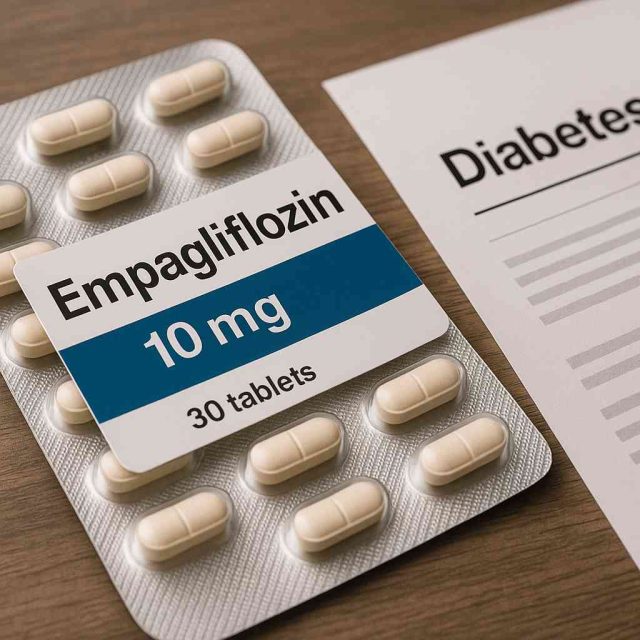Managing type 2 diabetes involves more than just monitoring blood sugar—it requires a proactive, comprehensive approach that includes the right medications. One such medication that has gained attention in recent years is Empagliflozin. Marketed under the brand name Jardiance, this drug is part of a newer class of type 2 diabetes treatments called SGLT2 inhibitors. But how does Empagliflozin work, and why is it becoming a staple in modern diabetes care?
Table of Contents
- Understanding Empagliflozin and Its Mechanism
- Key Benefits for Type 2 Diabetes Patients
- Safety Considerations and Common Side Effects
- Who Should and Shouldn’t Use Empagliflozin?
Understanding Empagliflozin and Its Mechanism
Empagliflozin helps manage type 2 diabetes by targeting the kidneys, not insulin. As an SGLT2 inhibitor, it blocks the sodium-glucose co-transporter 2 protein in the proximal tubules of the kidneys. This protein is responsible for reabsorbing glucose back into the bloodstream.
When this reabsorption is blocked, excess glucose is excreted in the urine, lowering blood sugar levels without requiring additional insulin production. Because of this unique mechanism, Empagliflozin works well with other diabetes medications, including metformin and DPP-4 inhibitors.
Additionally, its insulin-independent action makes it useful in patients with insulin resistance or beta-cell dysfunction. Unlike sulfonylureas or insulin injections, Empagliflozin does not usually cause hypoglycemia on its own, making it a safer choice for many.
To learn more about SGLT2 inhibitors and other glucose-lowering agents, explore the Diabetes in Control article archive.
Key Benefits for Type 2 Diabetes Patients
One of the most exciting aspects of Empagliflozin is its cardiovascular and renal protective effects, especially in patients with existing complications.
Empagliflozin has been shown to:
- Lower HbA1c levels by approximately 0.5% to 0.8%
- Promote modest weight loss by increasing urinary calorie loss
- Reduce blood pressure due to its mild diuretic effect
- Decrease hospitalization risk for heart failure
- Protect kidney function by lowering intraglomerular pressure and reducing albuminuria
The EMPA-REG OUTCOME trial demonstrated that Empagliflozin significantly reduced the risk of cardiovascular death in people with type 2 diabetes and established cardiovascular disease. This has led to broader use of the drug beyond glycemic control alone.
These benefits have made Empagliflozin a cornerstone in managing patients who not only struggle with blood sugar levels but also have overlapping heart or kidney conditions.
Safety Considerations and Common Side Effects
As with any medication, Empagliflozin comes with potential risks. While many patients tolerate the drug well, side effects may occur.
The most common include:
- Genital yeast infections (more common in women)
- Urinary tract infections
- Increased urination or thirst
- Mild dehydration
More serious risks, though less common, include:
- Ketoacidosis, even in the absence of high blood sugar
- Acute kidney injury, especially in volume-depleted patients
- Lower limb amputation risk, though more frequently reported with other SGLT2 inhibitors like canagliflozin
To minimize these risks, patients should stay well-hydrated, maintain proper hygiene, and report unusual symptoms such as severe fatigue or nausea. Providers should monitor kidney function and volume status regularly.
If you’re unsure about how to safely use Empagliflozin or manage side effects, consider speaking with a specialist through Healthcare.pro.
Who Should and Shouldn’t Use Empagliflozin?
Empagliflozin is primarily indicated for adults with type 2 diabetes. It is also approved to reduce the risk of cardiovascular death in adults with type 2 diabetes and established cardiovascular disease. More recently, it has been used to treat heart failure with preserved ejection fraction (HFpEF) and chronic kidney disease.
However, it is not approved for type 1 diabetes, due to the increased risk of diabetic ketoacidosis. People with advanced kidney disease (eGFR < 30 mL/min/1.73m²) should also avoid using this medication unless explicitly advised by a specialist.
Empagliflozin is a good option for:
- Patients not reaching goals on metformin alone
- Those with coexisting heart failure or CKD
- People aiming for weight reduction and blood pressure control
On the other hand, patients prone to urinary tract infections or severe dehydration should consider alternatives. As always, therapy must be personalized based on lifestyle, lab data, and comorbidities.
Conclusion
Empagliflozin represents a significant advancement in diabetes care. It offers glucose-lowering effects with the added benefit of cardiovascular and renal protection. For people with type 2 diabetes, especially those with overlapping health conditions, it provides a well-rounded therapeutic approach.
However, no drug is one-size-fits-all. Understanding how Empagliflozin works, who it benefits most, and what to watch for empowers both patients and providers to make better treatment decisions.
For ongoing updates on medication management, diabetes tools, and patient education, visit the Diabetes in Control article section.
FAQs
What is Empagliflozin used for?
Empagliflozin helps manage blood sugar in type 2 diabetes and reduces the risk of heart failure and kidney disease.
Can Empagliflozin be used with metformin?
Yes, it is often prescribed in combination with metformin to enhance glucose control.
Is weight loss a benefit of Empagliflozin?
Yes. Patients may experience modest weight loss due to glucose excretion through urine.
Does Empagliflozin lower blood pressure?
It can help lower blood pressure due to its mild diuretic effects.
Are there risks associated with Empagliflozin?
Risks include urinary tract infections, dehydration, and rare cases of ketoacidosis.
“This content is not medical advice. For any health issues, always consult a healthcare professional. In an emergency, call 911 or your local emergency services.”
